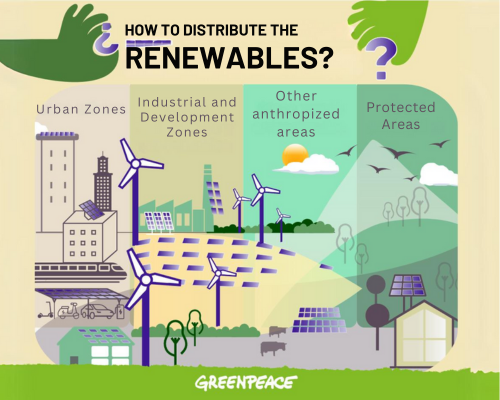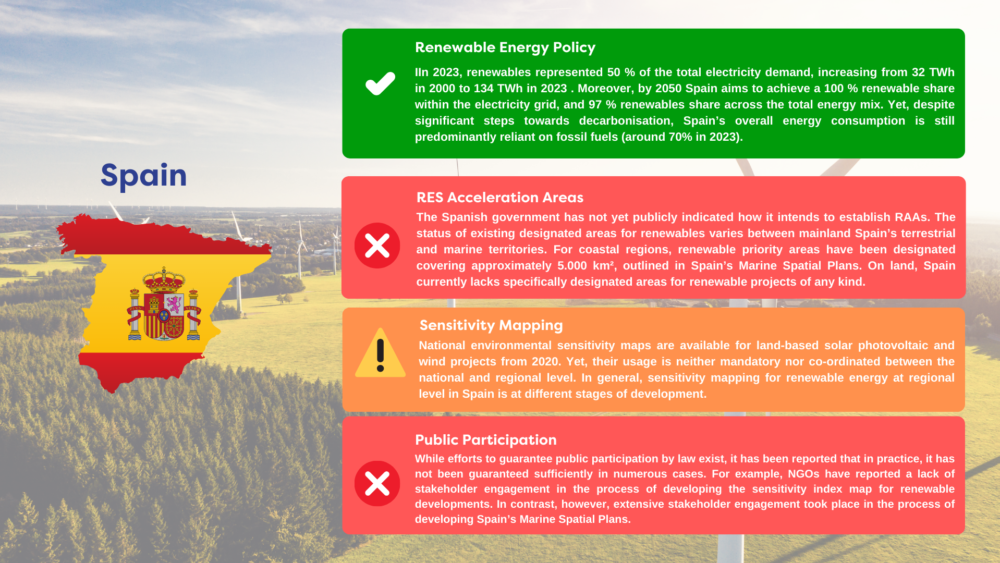
Written by Sara Pizzinato, Campaign Coordinator at Greenpeace Spain. Inspired by Greenpeace Spain’s blog: We need renewables, but we have to do it right.
Spain, like its neighbours in the mediterranean region, is now on the frontlines of the global climate crisis. Record breaking temperatures are leading to scorching heat waves, droughts and wildfires, having a major impact on people and nature. The way we produce and consume energy has a large role to play in this. Our current dependence on fossil fuels is fueling these climate disasters. The only real solution to resolve this issue is to decarbonise our energy consumption through reducing the energy we use and rapidly deploying wind and solar power to establish a 100% renewable energy system. Yet, for an energy transition to be successful, it needs people and nature at the heart of it.
The energy transition in Spain is already well underway. In 2023, renewable energy had managed to generate more electricity in Spain than fossil and nuclear energy combined. This led to energy costs for consumers across the country dropping by 13%. Moreover, together with the drop in electricity demand (-4% since 2021), the increase in renewable energy has contributed to significantly reducing greenhouse gas emissions in the Spanish electricity sector: 60% less in the last 15 years. Spain now has the potential to reduce its energy demand by half and to supply the rest of its energy entirely with renewables.
Yet, Spain imports almost all fossil fuels which are used to generate 78% of the energy consumed. In fact, the money spent on importing fossil fuels is equivalent to public spending on education in 2020. Rather than going overseas, into the pockets of large private corporations, this money can be spent accelerating Spain’s renewable energy transition in a just and nature-centred way . It can help people renovate their homes, install rooftop solar and establish local energy communities who can reap the full benefits of renewable energy.
Balancing speed with quality
A 100% renewable Spain can only be achieved through accelerating both offshore and onshore renewable energy. When it comes to developing renewable energy on land and in the sea, it is important that public participation and the protection of nature are key priorities in the planning process.
When it comes to best practices on selecting the areas for renewable energy development, early engagement with local stakeholders and communities is crucial as they can provide valuable input in the initial stages. Fostering transparency and trust early and help avoid any potential conflicts that might occur later and delay development. Moverover, the final outcome will serve the interests and needs of the local community, improving the overall public acceptance for renewable energy projects.
However, in Spain’s case, while efforts to guarantee public participation by law exist, it has been reported that in practice, that it has not been guaranteed sufficiently in numerous cases. For example, NGOs have reported a lack of stakeholder engagement in the process of developing the sensitivity index map for renewable developments.
There should also be stringent sensitivity mapping to ensure the most optimal land is chosen for development which will have minimal impact on both people and nature. Former industrial sites and degraded lands should be identified as priority areas for renewable energy as developments will have minimal impact on the environment.
There also needs to be a policy framework put in place for identifying dual land use areas. Developing renewable energy in conjunction with other land uses, such as agriculture, can reduce the land space needed. As of now, there is no formal policy in Spain that defines or regulates dual land use. As a result, there is no identification of suitable areas for dual use in sensitive mapping, nor is there any dialogue with farmers or local communities to identify potential opportunities for dual use.

Moreover, the designation of the acceleration areas should be done with strong consideration for Nature Restoration Plans, as it will ensure that renewables development supports broader environmental and biodiversity conservation goals and contribute to the restoration of degraded ecosystems. Of course, protected areas or areas of high environmental sensitivity where it is not already prohibited, should be avoided. And a reinforced public participation especially in the designation and evaluation of the acceleration areas.
In order to acquire the most accurate information when it comes to multilevel sensitivity mapping, strong coordination between national, regional and local spatial planning frameworks will be crucial. Member States need to establish clear visions, roadmaps, and guidelines at the national level that incorporate and recognise regional and local communities’ and authorities’ views and competences when it comes to accelerating the deployment of renewable energy.
Investing in grids and their proximity to new renewable energy projects are also an important consideration for developers. Although there is an urgent need to invest and expand the grid network in Spain, their environmental impact should be kept minimal. This can be achieved through coordinating spatial planning (including both generation and demand) with grid development plans and ensuring grid networks are close by to Renewable Acceleration Areas.

Source: https://caneurope.org/spatial-planning-for-renewables/
We need renewables, but we have to do it right
Renewable energy is picking up momentum throughout Spain and it is time for the Government to catch up. In 2023, Spain accounted for a quarter of the EU’s solar growth. Spain was also one of the main leaders in EU wind generation, just behind Germany. However, Spain has yet to fulfil its full potential when it comes to the deployment of wind and solar due to administrative shortcomings and the lack of transparency, spatial planning and of a clear public participation process beyond the environmental permitting. In order to overcome the administrative delays, investments are urgently needed in order to attract the relevant skilled people to the sector, and for the digital transformation of administrative systems to make them more efficient during the permitting process. Additionally, participative spatial planning for renewables deployment is urgently needed.
It is also important that Spain prioritises improving energy savings and promoting self-consumption through increasing the uptake of rooftop solar PV and helping to further grow the energy community movement. These measures in turn can help reduce the land needed for renewable energy development.
A recent study by the European Environmental Bureau found that the 5.2% land in Spain is suitable for renewable energy development. However, through significantly improving energy savings and promoting self-consumption practices, the land needed in Spain to reach a 100% renewable energy system by 2040 would only be 2.6%. This includes 0.5% for ground mounted Solar PV and 1.62% for onshore wind energy. Therefore, through implementing the appropriate safeguards, Spain can accelerate its transition to fully rely on renewable energy without significantly impacting either nature or fertile land suitable for food production



